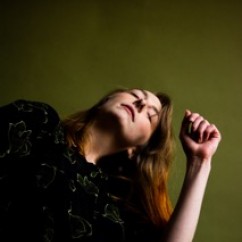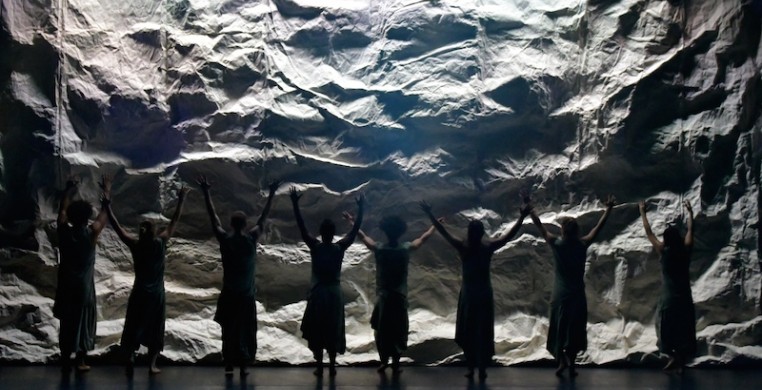“TEN” is an ambitious and highly physical work by UK-based choreographer José Agudo in collaboration with the dancers of ACE Dance and Music. While it originally premiered in 2017, it is being shown virtually as part of JOMBA! Contemporary Dance Experience’s 23rd annual festival. Its themes of leaving home, migration and imagined destinies are especially poignant now as we have all spent the last year and a half in and out of various stages of lockdown.
Agudo immediately transports us into a tense world as the lights come up on dancers standing in a single vertical line, their hands held behind their backs. The music, composed by Giuliano Modarelli and Vincenzo Lamagna, builds suspense until suddenly the dancers lunge and reach to the side, as sharp as the plucking of a guitar string. Agudo’s many influences, which include flamenco and kathak, are clear in his movement language that incorporates intricate footwork and evocative gestures. He has created phrases that repeat and build in momentum, each iteration of a particular phrase more physical than the last. The dancers wind and unwind, fold in on themselves and then suddenly explode, their limbs thrashing in all directions. Each section works them to the brink of exhaustion. It is in these moments where the dancers have been whipped into a frenzy, sweat beginning to drench their costumes, that we feel a sense of helplessness—that despite our best efforts to hope for some better outcome for ourselves, there is another force (society, environment, perhaps even fate) that keeps us rooted to our places.
This is a work that deals with several conflicts and contrasts—each one building the tension of the piece. Visceral sections are punctuated by moments of quiet stillness or gentle swaying. The dancers interrupt their own momentum in surprising ways and throw themselves off balance as if a strong wind is blowing them across the stage. While Agudo relies heavily on unison, the dancers stand out as individuals, each interpreting the movement in their own way. A central conflict emerges between two of the male dancers, with one trying desperately to leave the group while the other tries to pull him back in. In a duet that clearly draws on the choreographer’s own martial arts background, the two square off. Though there isn’t much partnering work in the more classical sense, the dancers maintain intense eye contact as they hurl themselves through the space trying to outdo the other with high flying jumps and dizzying turns.
Also at work in Agudo’s “TEN” is a sense of ritual. Each repetition of a phrase is as hypnotic as the piece’s entrancing music. The dancers pound the stage with their bare feet (and at times their fists) over rhythms that are layered under plucky or droning melodies, as if they are summoning some higher power. Even the piece’s title plays into this idea—10 being a number that often symbolizes the completion of a set. At the moment of the piece’s climax the dancers drop to their knees at the front of the stage behind small piles of sand and begin to fling particles into the air and scatter them across the floor. Ashes to ashes, dust to dust—eventually all things are returned to their original state and we are reminded that we are defenseless against the forces of change.
It is fitting that ACE Music and Dance would present this work as part of the 23rd annual JOMBA! festival, the theme of which is border crossings. The piece itself is a fusion of many different styles that represent Agudo’s multifaceted dance background. But it also tells a story of migration and struggle. As the South African based choreographer Jay Pather mentioned in an address on the festival’s opening night on Aug. 24, border crossings are messy, both physically and spiritually. They can represent both internal and external struggle. Crossing a border can be an act of defiance, full of risk and danger, while the act of crossing spiritual or emotional borders forces us to confront our demons and vulnerabilities. While we have all been sequestered at home at various points during the pandemic, technology has also helped us to cross boarders virtually and engage with viewpoints and art forms from around the globe.
--
The JOMBA! Contemporary Dance Experience continues with daily shows online through Sept. 5. For more information and to access the performances, visit jomba.ukzn.ac.za.

2021 Critical Dance Writing Fellow Rachel Schmidt received her BFA in dance from Jordan College of the Arts at Butler University. Upon graduating, she moved to San Francisco, California where she danced as a trainee with Alonzo King’s LINES Ballet and dawsondancesf, directed by Gregory Dawson. She has performed in works by Alonzo King, Sidra Bell, David Harvey, Maurya Kerr, Erik Wagner, Susan McGuire, and emerging choreographers as part of Dance Lab New York’s Alchemy Lab Cycle which was shown at the Guggenheim Museum. She is currently a freelance dancer based in New York City.

